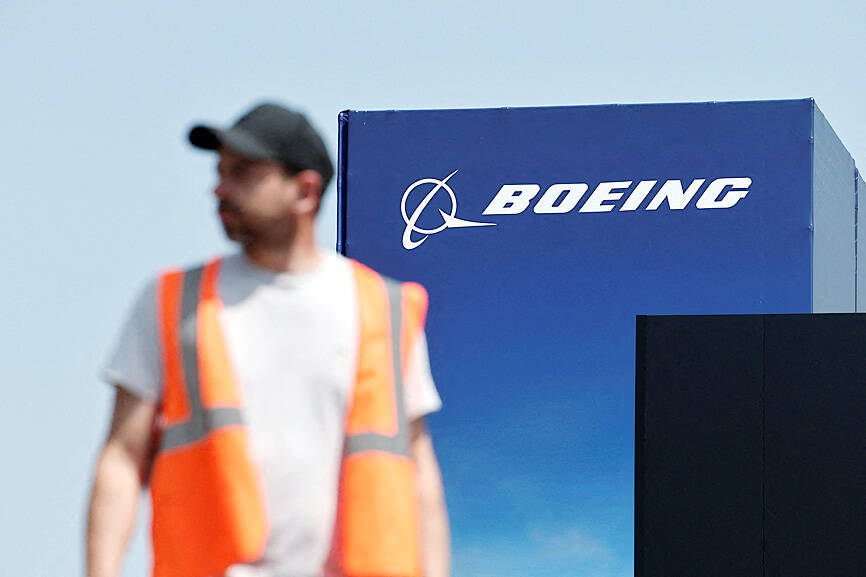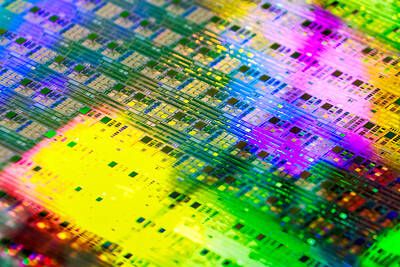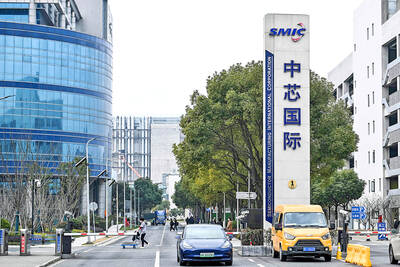The global commercial aviation fleet would stand just under 50,000 planes in 2044, with most built over the next 20 years, a Boeing Co forecast released on Saturday said.
The global fleet would nearly double to 49,600, a bit below Boeing’s prior annual outlook, the company said ahead of the Paris Air Show beginning today.
Emerging markets “with expanding middle classes, dynamic and competitive airline networks and sustained aviation investment” would represent more than 50 percent of the commercial fleet in 2044, up from nearly 40 percent last year, Boeing said.

Photo: Reuters
However, the forecast also showed the effects of supply chain difficulties in the wake of the COVID-19 pandemic.
“The supply chain has probably had a small role in our slight reduction in deliveries over the next 20 years,” Boeing commercial marketing vice president Darren Hulst said at a briefing on Tuesday.
The briefing came before Thursday’s deadly Air India crash of a Boeing 787 Dreamliner.
Following the crash, which killed at least 279 people, Boeing CEO Kelly Ortberg and commercial plane chief Stephanie Pope canceled plans to attend.
The Boeing forecast projects annual passenger growth of 4.2 percent, above the 2.3 percent annual growth in GDP.
“New aircraft deliveries haven’t been able to keep up with the demand,” said Hulst, who estimates that the problem has resulted in a “cumulative shortage” of about 1,500 to 2,000 planes.
However, Hulst said he expects the cadence of deliveries to pick up between now and the end of the decade.
Of the 43,600 new planes required between now and 2044, an estimated 21,100 would replace existing fleet and 22,500 would be needed to address rising demand in China and emerging markets.
These figures indicate an expected dramatic expansion of the global air fleet over four decades from 2004, when the fleet consisted of just 16,780 planes.
In a sign of how the aviation market has changed, the 10 biggest aviation companies in 2004 accounted for 45 percent of the global fleet and were dominated by companies from North America and Europe.
Today’s top 10 account for just 30 percent of the market and are composed of a greater share of companies from Asia and the Middle East — a region that had no companies in the top 10 in the earlier period.

SEMICONDUCTOR SERVICES: A company executive said that Taiwanese firms must think about how to participate in global supply chains and lift their competitiveness Taiwan Semiconductor Manufacturing Co (TSMC, 台積電) yesterday said it expects to launch its first multifunctional service center in Pingtung County in the middle of 2027, in a bid to foster a resilient high-tech facility construction ecosystem. TSMC broached the idea of creating a center two or three years ago when it started building new manufacturing capacity in the US and Japan, the company said. The center, dubbed an “ecosystem park,” would assist local manufacturing facility construction partners to upgrade their capabilities and secure more deals from other global chipmakers such as Intel Corp, Micron Technology Inc and Infineon Technologies AG, TSMC said. It

NO BREAKTHROUGH? More substantial ‘deliverables,’ such as tariff reductions, would likely be saved for a meeting between Trump and Xi later this year, a trade expert said China launched two probes targeting the US semiconductor sector on Saturday ahead of talks between the two nations in Spain this week on trade, national security and the ownership of social media platform TikTok. China’s Ministry of Commerce announced an anti-dumping investigation into certain analog integrated circuits (ICs) imported from the US. The investigation is to target some commodity interface ICs and gate driver ICs, which are commonly made by US companies such as Texas Instruments Inc and ON Semiconductor Corp. The ministry also announced an anti-discrimination probe into US measures against China’s chip sector. US measures such as export curbs and tariffs

The US on Friday penalized two Chinese firms that acquired US chipmaking equipment for China’s top chipmaker, Semiconductor Manufacturing International Corp (SMIC, 中芯國際), including them among 32 entities that were added to the US Department of Commerce’s restricted trade list, a US government posting showed. Twenty-three of the 32 are in China. GMC Semiconductor Technology (Wuxi) Co (吉姆西半導體科技) and Jicun Semiconductor Technology (Shanghai) Co (吉存半導體科技) were placed on the list, formally known as the Entity List, for acquiring equipment for SMIC Northern Integrated Circuit Manufacturing (Beijing) Corp (中芯北方積體電路) and Semiconductor Manufacturing International (Beijing) Corp (中芯北京), the US Federal Register posting said. The

India’s ban of online money-based games could drive addicts to unregulated apps and offshore platforms that pose new financial and social risks, fantasy-sports gaming experts say. Indian Prime Minister Narendra Modi’s government banned real-money online games late last month, citing financial losses and addiction, leading to a shutdown of many apps offering paid fantasy cricket, rummy and poker games. “Many will move to offshore platforms, because of the addictive nature — they will find alternate means to get that dopamine hit,” said Viren Hemrajani, a Mumbai-based fantasy cricket analyst. “It [also] leads to fraud and scams, because everything is now